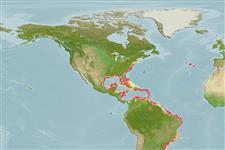Common names from other countries
>
Carangiformes (Jacks) >
Carangidae (Jacks and pompanos) > Naucratinae
Etymology: Seriola: Latin word diminutive with the meaning of a large earthenware pot (Ref. 45335).
More on author: Bloch.
Environment: milieu / climate zone / depth range / distribution range
Ecología
marino bentopelágico; rango de profundidad 55 - 348 m (Ref. 51158). Subtropical; 43°N - 30°S, 98°W - 15°W
Western Atlantic: Massachusetts, USA to Brazil. Eastern Atlantic: Madeira (Ref. 7097); Turkey (Ref. 95646); eastern Atlantic distribution is uncertain due to past confusion with Seriola carpenteri.
Tamaño / Peso / Age
Maturity: Lm ? range ? - ? cm
Max length : 67.5 cm FL macho / no sexado; (Ref. 26340); common length : 50.0 cm TL macho / no sexado; (Ref. 5217); peso máximo publicado: 4.6 kg (Ref. 3195)
Espinas dorsales (total) : 9; Radios blandos dorsales (total) : 28 - 33; Radios blandos anales: 17 - 20.
Adults are benthopelagic near the coasts (Ref. 5217). Smaller juveniles epipelagic in oceanic or offshore neritic waters. Adults feed on squids and fishes (Ref. 4233). Eggs are pelagic (Ref. 4233).
Life cycle and mating behavior
Maturities | Reproducción | Spawnings | Egg(s) | Fecundities | Larva
Smith-Vaniz, W.F., J.-C. Quéro and M. Desoutter, 1990. Carangidae. p. 729-755. In J.C. Quero, J.C. Hureau, C. Karrer, A. Post and L. Saldanha (eds.) Check-list of the fishes of the eastern tropical Atlantic (CLOFETA). JNICT, Lisbon; SEI, Paris; and UNESCO, Paris. Vol. 2. (Ref. 7097)
IUCN Red List Status (Ref. 130435)
CITES (Ref. 128078)
Not Evaluated
Threat to humans
Reports of ciguatera poisoning (Ref. 30911)
Human uses
Pesquerías: pesquerías de subsistencia; pesca deportiva: si
Herramientas
Special reports
Download XML
Fuentes de Internet
Estimates based on models
Preferred temperature (Ref.
115969): 17.7 - 26.5, mean 23.3 (based on 70 cells).
Phylogenetic diversity index (Ref.
82804): PD
50 = 0.5020 [Uniqueness, from 0.5 = low to 2.0 = high].
Bayesian length-weight: a=0.01549 (0.00869 - 0.02760), b=2.95 (2.79 - 3.11), in cm Total Length, based on LWR estimates for this species & (Sub)family-body (Ref.
93245).
Nivel trófico (Ref.
69278): 4.6 ±0.57 se; based on food items.
Resiliencia (Ref.
120179): Medio, población duplicada en un tiempo mínimo de 1.4-4.4 años (Preliminary K or Fecundity.).
Fishing Vulnerability (Ref.
59153): Moderate to high vulnerability (50 of 100).
